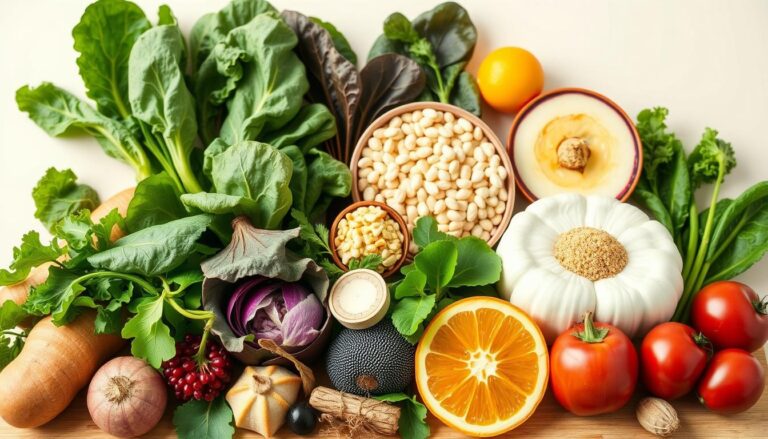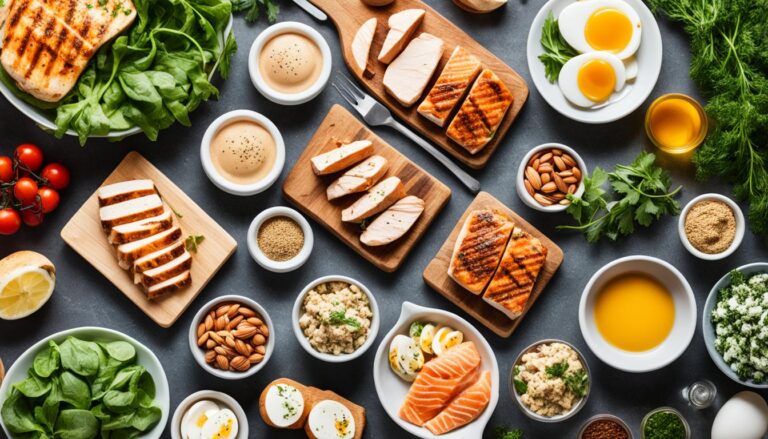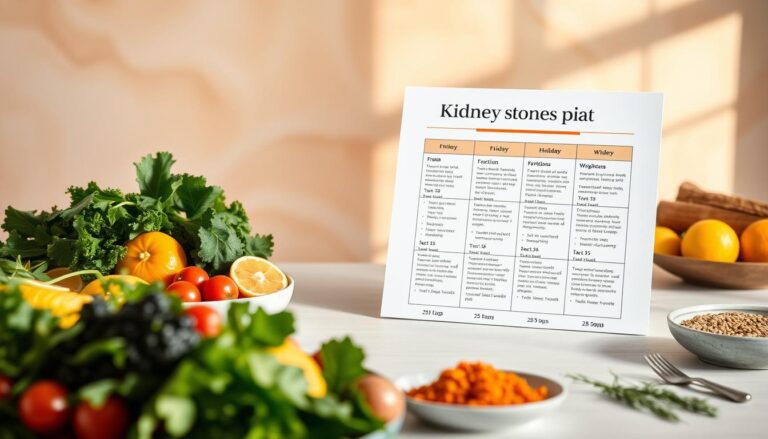Can the right foods really help you achieve your weight loss goals? The answer lies in understanding how specific nutrient-dense foods can support a healthy diet.
A well-balanced diet is crucial for effective weight loss. Certain foods have been scientifically validated to help manage hunger, boost metabolism, and contribute to overall health.
By incorporating the right foods into your meal plan, you can naturally support your weight management goals without resorting to restrictive eating. This guide highlights evidence-backed foods that can be part of a sustainable diet.
Key Takeaways
- Eat nutrient-dense foods to support weight loss.
- Specific foods can help manage hunger and boost metabolism.
- A balanced diet is crucial for effective weight management.
- Incorporating the right foods can support overall health.
- Sustainable weight loss is achieved through a combination of healthy eating habits.
Understanding the Science Behind Weight Loss Foods
Understanding how different foods affect weight loss involves examining their macronutrient composition, energy density, and the physiological responses they trigger. Research suggests that including fiber-rich foods in your diet helps curb your appetite. Foods that contain more water and fewer calories are particularly effective for weight management.
The scientific mechanisms behind weight loss foods are multifaceted. Macronutrient composition plays a crucial role, with protein being particularly significant due to its role in increasing thermogenesis and preserving lean muscle mass. The concept of energy density is also vital; foods with high water and fiber content but low calorie density help create feelings of fullness.
Studies have shown that certain nutrients affect hormones that regulate hunger and fullness, such as ghrelin and leptin. For instance, protein-rich foods can enhance satiety by influencing these hormones. Moreover, the role of nutrients in stabilizing blood sugar levels and enhancing metabolic rate is crucial for effective weight loss.
By understanding these principles, it becomes clear why certain foods are more effective for weight management. The interplay between nutrients, satiety, and metabolic rate underscores the importance of choosing the right foods for a successful weight loss journey.
16 Healthy Foods That Actually Help You Lose Weight, According to Science
Eating the right foods can make a significant difference in your weight loss journey. The following 16 foods have been identified as beneficial for weight management, backed by scientific evidence.
These foods share common characteristics such as high nutrient and protein content, healthy fats, and low energy density. They can be easily incorporated into various dietary patterns and cultural preferences, making it easier to stick to a healthy diet.
The selected foods not only support weight loss but also contribute to overall health. By consuming these foods as part of a balanced diet, individuals can manage their calories intake more effectively.

These foods are rich in essential nutrients and can be enjoyed in a variety of ways, making it easier to maintain a healthy diet and achieve your weight loss goals.
Eggs: The Protein-Packed Breakfast Champion
Packed with protein and low in calories, eggs are a champion breakfast food for weight loss. Eggs are an excellent source of high-quality protein, which takes longer to digest, leaving you feeling satisfied and less likely to overeat at your next meal.
An Australian study demonstrated that participants who ate eggs for breakfast felt less hungry and consumed significantly fewer calories at lunch compared to those who had cereal. This supports the role of eggs in enhancing satiety and aiding in weight management.
| Nutrient | Value per Large Egg |
|---|---|
| Calories | 78 |
| Protein | 6.3 grams |
| Fat | 5.3 grams |
Egg consumption can be varied – from hard-boiled eggs to omelets, offering flexibility in incorporating them into a weight-loss diet. The protein in eggs also helps stabilize blood sugar levels, preventing energy crashes that can lead to unhealthy snacking. With their versatility and nutritional profile, eggs are a valuable addition to a weight management journey.
Oats: The Fiber-Rich Morning Staple
Oatmeal, a simple yet potent breakfast option, is backed by science for its weight loss benefits. A cup of cooked oatmeal contains approximately 160 calories and nearly 4 grams of soluble fiber called beta-glucan. This fiber promotes a feeling of fullness and helps regulate blood sugar levels, preventing spikes and crashes that can lead to overeating.
The nutritional profile of oats highlights their relatively low calorie content, complex carbohydrates, and essential nutrients. Research has linked regular oat consumption to lower body weight and reduced risk of obesity.
| Type of Oats | Fiber Content | Preparation Time |
| — | — | — |
| Steel-Cut Oats | High | 20-30 minutes |
| Rolled Oats | Medium | 5-10 minutes |
| Instant Oats | Low | 1-2 minutes |
To maximize the weight loss benefits of oats, it’s recommended to prepare them with healthy toppings such as fresh fruits and nuts. Incorporating oats into your diet beyond breakfast, such as using oat flour in baking or adding oats to savory dishes, can also contribute to a successful weight loss regimen.
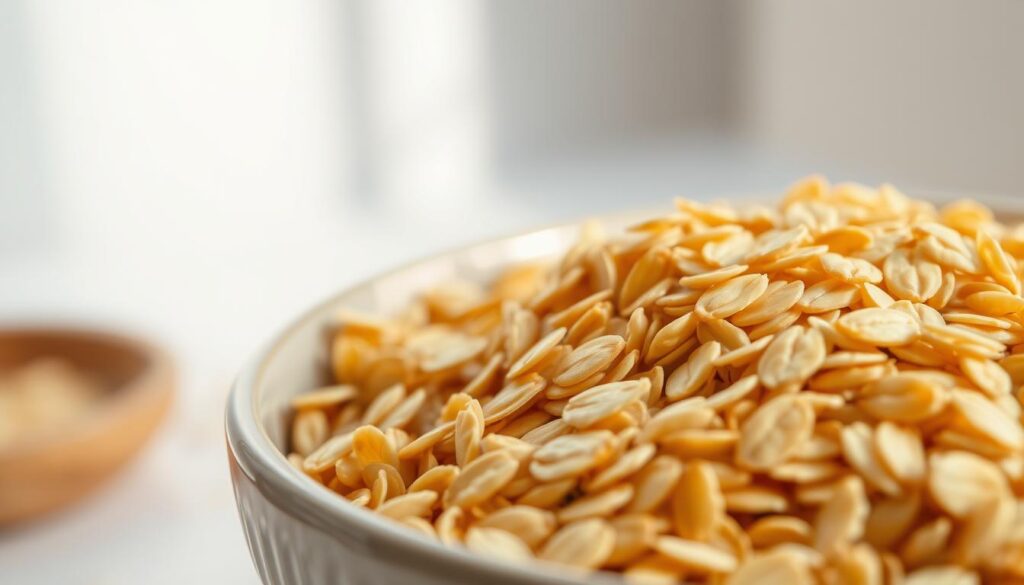
Oats are a versatile and nutritious addition to a weight loss diet, providing sustained energy and helping to manage hunger.
Blueberries and Other Berries: Antioxidant Powerhouses
Berries, particularly blueberries, raspberries, and strawberries, are emerging as crucial components in the pursuit of effective weight management. Thesefruitsare rich in antioxidants, with blueberries being a standout due to their high levels of anthocyanins.
Anthocyanins not only support overall health but may also aid in maintaining a healthy weight and reducing inflammation. Raspberries, for instance, offer a significant fiber content of 8 grams per cup, making them a nutrient-dense, low-calorie food choice. The high fiber-to-sugar ratio in berries satisfies sweet cravings with minimal impact on blood sugar levels.
Berries are also characterized by their low calorie density and high water content, making them ideal for those conscious of their weight. Incorporating berries into daily meals, whether as a breakfast addition or a healthy dessert, can provide essential nutrients while supporting overall health.
Salmon: Essential Omega-3 Fatty Acids
Salmon stands out as a nutritional powerhouse, offering a rich source of omega-3 fatty acids crucial for overall health and weight management. According to recent research, when combined with a calorie-controlled diet, eating seafood such as salmon may increase weight loss. The versatile pink fish is fairly low in calories, at less than 200 for a 3-ounce serving, and it’s packed with essential omega-3 fatty acids, which we need to get regularly from our diet, since our body can’t produce them.
These nutritious fatty acids can contribute to a healthy heart as well as benefit cholesterol, triglycerides, inflammation, and even blood clotting. The combination of healthy fats and protein in salmon makes it extremely satisfying, helping to control hunger between meals. Moreover, the omega-3 fatty acids in salmon play a significant role in reducing inflammation and potentially improving fat metabolism, making it an excellent food for weight management.
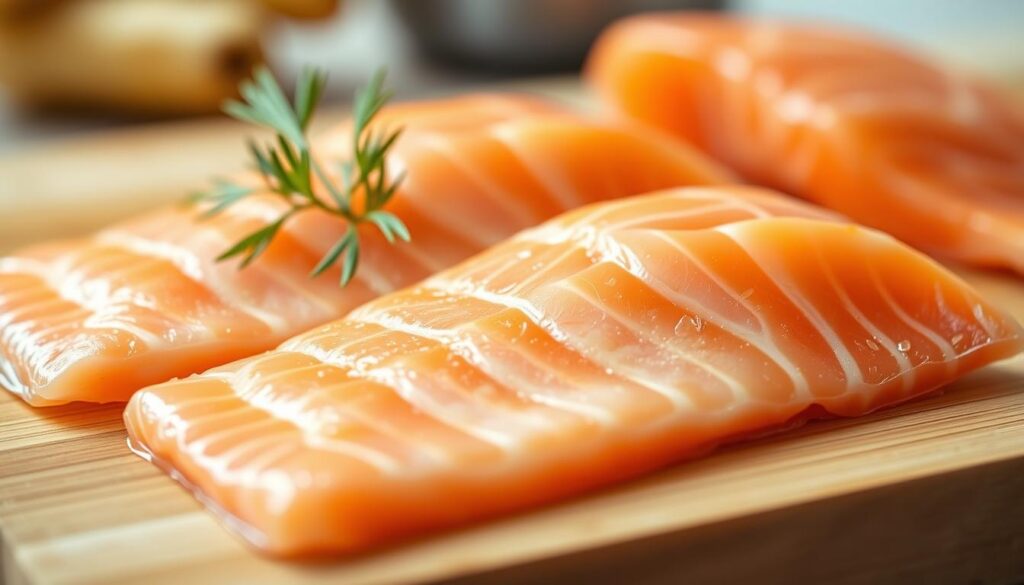
Practical cooking methods such as grilling, baking, or poaching can preserve salmon’s nutritional benefits while keeping added calories low. Beyond weight management, regular salmon consumption has additional health benefits, including improved heart health and cognitive function. When choosing salmon, considering sustainable sourcing can help readers make environmentally conscious choices.
| Nutrient | Amount per 3 oz serving | Benefit |
|---|---|---|
| Calories | Less than 200 | Low calorie count supports weight loss |
| Omega-3 Fatty Acids | High content | Reduces inflammation, improves heart health |
| Protein | High quality | Increases satiety, supports muscle health |
Dark Leafy Greens: Low-Calorie Nutrient Density
Dark leafy greens are exceptionally nutritious, providing essential vitamins and minerals with minimal calories, making them perfect for a weight loss meal plan. These greens, including kale, spinach, arugula, and collard greens, are rich in vitamins A, C, and K, and minerals like calcium and potassium.
The high nutrient density of leafy greens is attributed to their richness in fiber and water content, which promotes satiety and supports weight loss. According to Rush University System in Chicago, the fiber in these greens slows digestion, keeping you feeling fuller for longer.
Some examples of nutrient-dense leafy greens include:
- Kale: Virtually fat-free, with about 30 calories per cup, alongside good amounts of vitamins A, K, C, B6, calcium, potassium, and magnesium.
- Spinach: Loaded with minerals like potassium, which helps offset the effects of sodium.
- Arugula and Collard Greens: Rich in vitamins and minerals, adding variety to salads and meals.
Nutritional Benefits of Leafy Greens
| Green | Calories per Cup | Key Nutrients |
|---|---|---|
| Kale | 30 | Vitamins A, K, C, B6, Calcium, Potassium, Magnesium |
| Spinach | 7 | Potassium, Iron, Vitamins A and K |
| Arugula | 5 | Vitamin K, Calcium, Potassium |
“Incorporating a variety of leafy greens into your diet can significantly enhance your nutrient intake while supporting your weight loss goals.”
To incorporate more leafy greens into your diet, try adding them to salads, blending them into smoothies, or cooking them as a side dish. Their versatility and nutritional benefits make them an ideal component of a healthy meal plan.
Chickpeas and Legumes: Plant-Based Protein Sources
Legumes, including chickpeas, lentils, and beans, are plant-based protein sources that support weight management. These nutritionally dense foods are rich in protein and fiber, making them an ideal addition to a weight loss diet. The unique combination ofprotein and fiberin legumes creates a powerful satiety effect, helping to control hunger and reduce overall calorie intake.
Research has shown that incorporating legumes into your meals can lead to significant weight loss benefits. A study from the University of Toronto found that participants who added less than a cup of legumes to their daily food intake lost an average of ¾ of a pound over six weeks. Moreover, this modest amount helped prevent them from gaining it back.
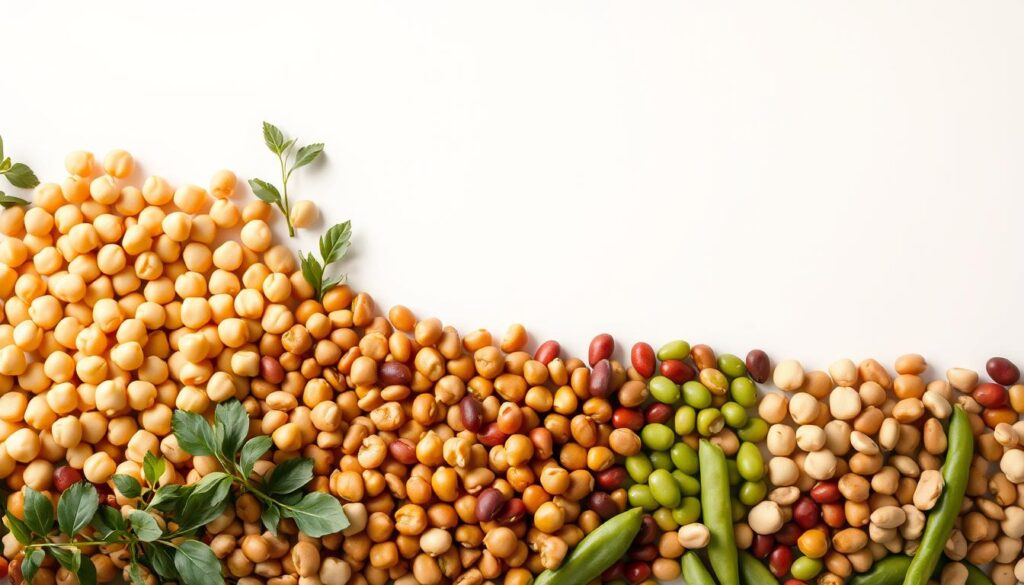
Legumes are also low in energy density, providing substantial nutrition for relatively few calories. They help stabilize blood sugar levels, preventing energy crashes that can lead to unhealthy snacking. With their versatility in various cuisines and preparation methods, legumes can be easily incorporated into meals, from salads and soups to main dishes. Additionally, they are budget-friendly, making healthy eating more accessible. Beyond weight management, legumes offer additional health benefits, including heart health and gut microbiome support.
Avocados: Healthy Fats for Satiety
Despite being calorie-dense, avocados can play a crucial role in a weight loss diet due to their unique nutritional profile. Avocados are rich in healthy fats, particularly monounsaturated fatty acids, which promote satiety and may help reduce visceral fat accumulation.
A study demonstrated that daily Hass avocado consumption, in addition to a calorie-controlled diet, supported weight loss and had numerous other benefits. The high fiber content in avocados contributes to their satiating effect and supports digestive health. Additionally, avocados are a good source of vitamin E, lutein, and other essential nutrients.
To incorporate avocados effectively into a weight loss diet, it’s essential to be mindful of portion sizes due to their high calories and fats content. Avocados can be versatilely added to various meals, from breakfast to dinner options, enhancing both the nutritional value and the flavor.
Nuts and Seeds: Nutrient-Dense Snacking Options
Despite being calorie-dense, nuts and seeds can be a valuable addition to a weight management plan. Research has shown that regular consumption of nuts is associated with less weight gain over time. This is attributed to their unique combination of protein, fiber, and healthy fats, which creates a strong satiety effect, keeping you fuller for longer.
Nuts like almonds, walnuts, and pistachios, and seeds such as chia and flax, are particularly beneficial. For example, pistachios are packed with 6 grams of plant protein per serving and are rich in essential amino acids. However, it’s crucial to practice portion control due to their high calorie content; a serving size is typically about a handful.
- Incorporate nuts and seeds into your diet as a healthy snacking option.
- Use them to add texture and nutrition to meals.
- Be mindful of portion sizes to avoid excessive calorie intake.
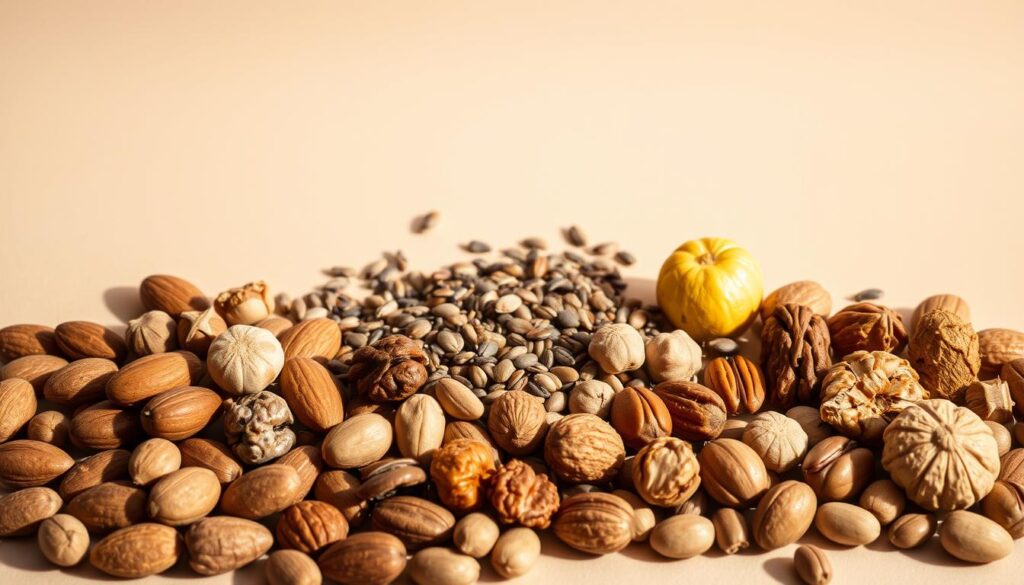
Beyond weight management, nuts and seeds offer additional health benefits, including heart health and anti-inflammatory effects. The act of shelling nuts like pistachios can also slow down your eating pace, potentially reducing overall consumption.
Greek Yogurt and Kefir: Probiotic-Rich Dairy Options
The nutritional profile of Greek yogurt and kefir makes them excellent choices for those seeking to manage their weight. Both are rich in protein and contain probiotics, which support gut health.
Greek yogurt is particularly notable for its high protein content compared to regular yogurt. This increased protein level can enhance satiety, potentially aiding in weight loss. Additionally, the probiotics in Greek yogurt and kefir contribute to a healthy gut microbiome, which recent studies suggest may be linked to weight management.
In terms of nutritional value, one cup of kefir contains approximately 100 calories and 10 grams of protein, making it a nutrient-dense food choice. When selecting Greek yogurt or kefir, it’s essential to choose products with minimal added sugar to maximize their health benefits.
| Nutrient | Greek Yogurt (1 cup) | Kefir (1 cup) |
|---|---|---|
| Calories | 100-150 | 100 |
| Protein | 15-20 grams | 10 grams |
| Probiotics | Present | Present |
These dairy products can be easily incorporated into a diet aimed at weight loss. They can be enjoyed as a breakfast option, used as a base for smoothies, or served as a snack. Furthermore, Greek yogurt can be used as a substitute for higher-calorie ingredients like sour cream or mayonnaise in various recipes.
Quinoa: Complete Plant Protein
Quinoa is a versatile and nutritious grain that provides all nine essential amino acids, making it a complete protein source beneficial for weight loss.
Unlike many plant-based foods, quinoa is an unusual complete protein, offering a balanced amino acid profile that’s crucial for muscle maintenance during weight management.
It’s also extremely high in fiber, promoting satiety and supporting digestive health, which are key factors in managing calories and supporting overall health.
Quinoa is a grain that provides sustained energy and helps stabilize blood sugar levels due to its low glycemic index, preventing energy crashes that can lead to unhealthy snacking.
| Nutritional Aspect | Quinoa | Refined Grains |
|---|---|---|
| Protein Content | Complete protein source | Limited protein content |
| Fiber Content | High in fiber | Low in fiber |
| Glycemic Index | Low glycemic index | High glycemic index |
Incorporating quinoa into meals is straightforward; it can be used in breakfast bowls, lunch salads, or as a dinner side, offering a nutrient-rich alternative to refined carbohydrates.
Overall, quinoa is a must-add to any kitchen for promoting sustained weight management and overall nutritional well-being.
Broccoli and Other Non-Starchy Vegetables
Non-starchy vegetables like broccoli are not only low in calories but also rich in fiber, making them ideal for weight loss. Broccoli, for instance, contains more than 90% water, with the remaining composition consisting of carbs, protein, and a small amount of fat.
With approximately 35 calories per cup, broccoli is a filling food that can help control weight due to its high fiber content. The florets of broccoli have a higher concentration of nutrients and phytochemicals compared to its leaves and stems.
Nutrient Profile of Non-Starchy Vegetables
| Vegetable | Calories per Cup | Fiber Content | Water Content |
|---|---|---|---|
| Broccoli | 35 | High | >90% |
| Cauliflower | 25 | High | >90% |
| Spinach | 7 | High | >90% |
Incorporating non-starchy vegetables into meals can create visually satisfying portions that support natural portion control. The thermogenic effect of these vegetables also means the body expends energy to digest them, further aiding in weight management.
Practical cooking methods such as steaming or roasting can preserve the nutritional value of these vegetables while enhancing their flavor. Regular consumption can be encouraged by incorporating them into daily meals, from simple side dishes to creative main courses.
Potatoes: Surprisingly Satisfying Complex Carbs
Despite common misconceptions, potatoes can be a valuable addition to a weight loss diet when prepared correctly. Research has shown that boiled potatoes are surprisingly satiating, making them a great choice for those looking to lose weight.
The key lies in how potatoes are prepared. Boiled potatoes have been proven to be the most satiating, according to researchers at the University of Sydney. To make the most of this effect, registered dietitian Azmina Govindji suggests making a potato salad with the skins on, mixed with Greek yoghurt and sweetcorn, which adds protein and fibre, enhancing the feeling of fullness.
Potatoes are rich in complex carbs, energy-providing nutrients, and are a good source of potassium, vitamin C, and fibre, especially when consumed with the skin. The calories in potatoes are relatively low if they are cooked healthily. As part of a balanced meal, potatoes can help satisfy carbohydrate cravings in a more nutritious way than processed alternatives, potentially reducing overall dietary calorie intake.
Soups and Broths: Liquid Satiety Enhancers
Soups and broths have emerged as valuable allies in weight loss efforts, thanks to their satiety-enhancing properties. Research has demonstrated that consuming soup before a meal can lead to a reduction in overall calorie intake at that meal and potentially throughout the day.
A clinical study conducted by Dr. Rolls found that women who were served a chicken and rice soup before lunch reported feeling fuller than those who were served a chicken and rice casserole or a casserole with a glass of water. Notably, the soup-eaters consumed around 100 fewer calories at lunch without compensating at dinner.
- The science behind soup’s satiety effect involves slower gastric emptying and cognitive factors related to seeing a larger volume of food.
- Various types of soups, from bone broth to vegetable-based options, offer different nutritional benefits that can support weight loss efforts.
- The high water content and relatively low energy density of soups contribute to feelings of fullness with minimal caloric impact.
To incorporate soups and broths into a weight loss meal plan, consider using them as starters or main courses. Be mindful of added sodium, fats, and refined carbohydrates in commercial soups, and opt for nutrient-rich, homemade soups instead.
Foods to Limit When Trying to Lose Weight
For those on a weight loss journey, understanding the pitfalls of certain ‘healthy’ foods is essential. Many foods marketed as healthy options can actually hinder weight loss efforts due to their high calories, sugar, and unhealthy fat content.
Some seemingly innocuous foods can be detrimental to a diet. For instance, fruit-flavored yogurt can contain up to 31 grams of sugar per 6-ounce serving. Fast-food salads, despite being perceived as healthy, can rack up calories due to dressings and add-ons. Enhanced water and refined grains are other culprits that can impede weight loss.
| Food | Hidden Calories/Sugar | Healthier Alternative |
|---|---|---|
| Fruit-flavored Yogurt | Up to 31g sugar per 6oz serving | Plain, unflavored yogurt |
| Fast-food Salads | Up to 500 calories with dressings | Homemade salads with light dressing |
| Enhanced Water | Artificial flavors and sweeteners | Infused water or unsweetened tea |
| Refined Grains | Low in fiber, high in empty calories | Whole grains like quinoa or brown rice |
By being mindful of these foods and opting for healthier alternatives, individuals can better achieve their lose weight goals. Reading food labels carefully and choosing whole, nutrient-dense foods is crucial for successful weight management.
Incorporating Weight-Loss Foods Into Your Daily Diet
To achieve and maintain weight loss, it’s essential to focus on nutrient-dense foods. Incorporating the 16 weight-loss foods into your daily meals can be straightforward with a few simple strategies.
Start by stocking up on a variety of whole foods, including fruits, vegetables, lean proteins, and whole grains. Consider keeping frozen and canned options on hand to avoid spoilage. For example, rinsing canned foods can help remove excess sodium and preservatives.
Creating balanced meals that combine multiple weight-loss-friendly foods can maximize satiety and nutritional benefits. A hearty salad with kale, roasted sweet potatoes, walnuts, goat cheese, and a vinaigrette, served with a salmon fillet, makes for a nutritious and filling meal.
By making gradual changes to your diet and practicing mindful eating, you can develop sustainable healthy eating patterns. This approach, rather than restrictive dieting, is key to long-term weight management and overall health enhancement.
By incorporating these foods and strategies into your daily routine, you can achieve your weight loss goals and enjoy improved energy and better digestion.


